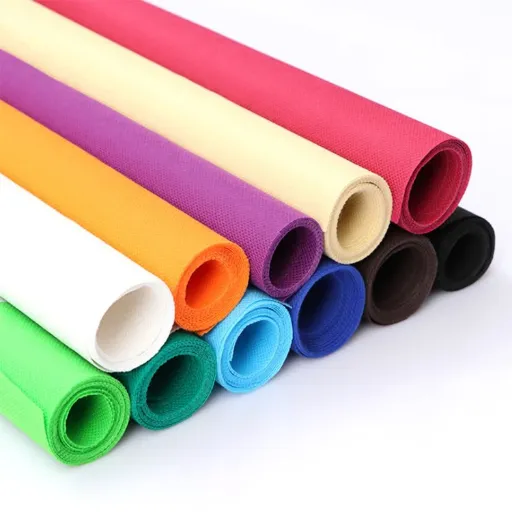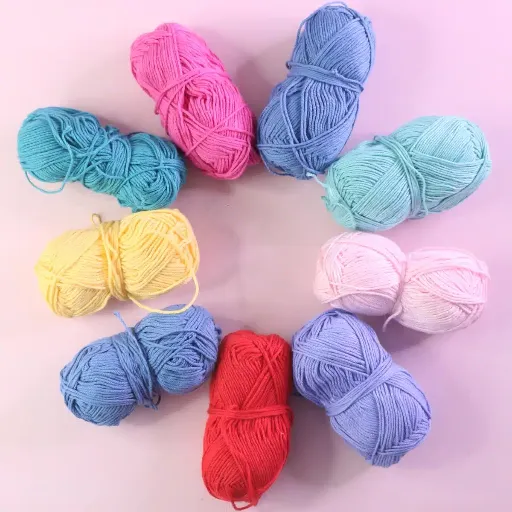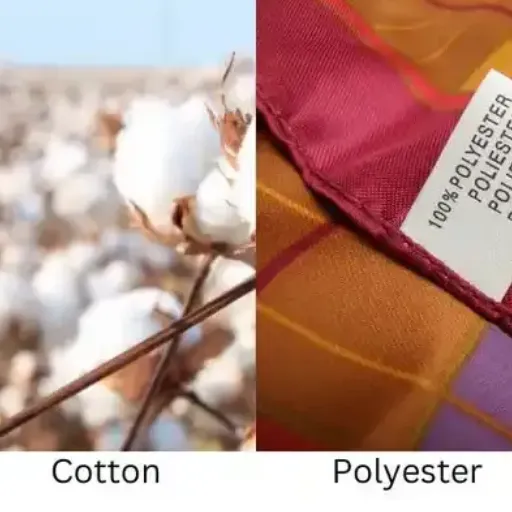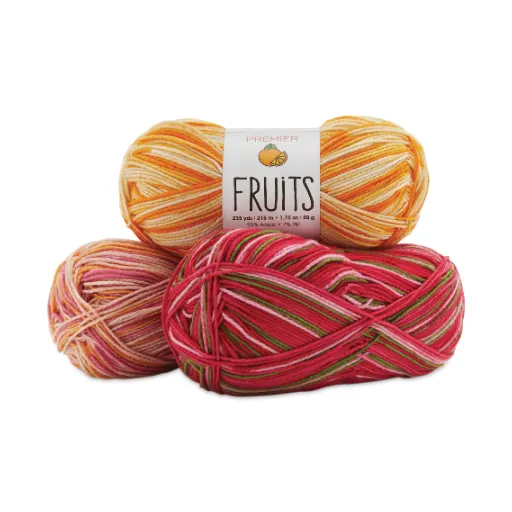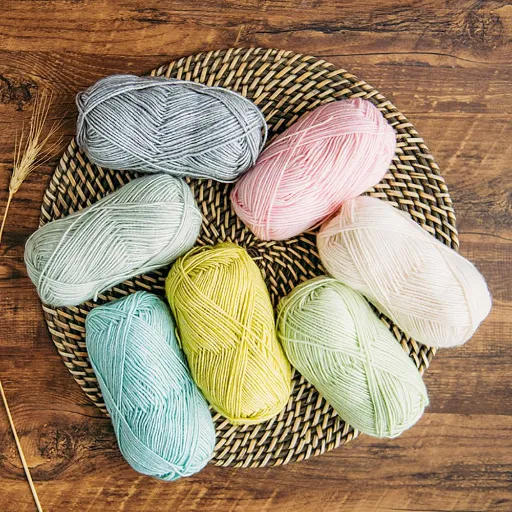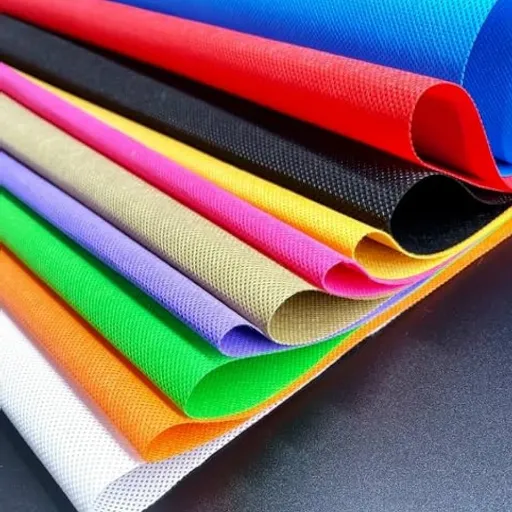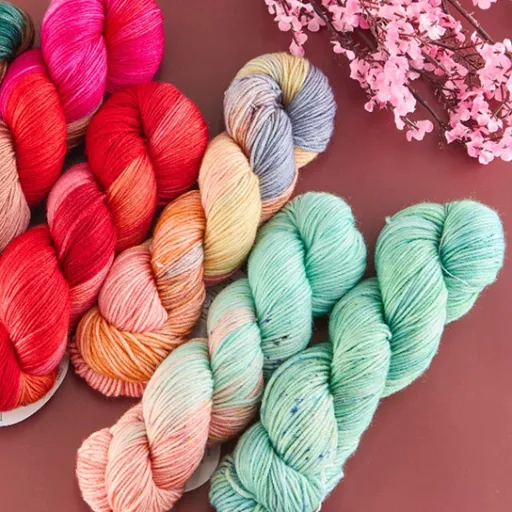It’s said that sewing threads are the ones that deserve the most credit when it comes to every sewn item that is made. They happen to be the base and the finishing touch of any sewn project. The ability to solve the plethora of thread types and their various uses is an essential aspect for anyone involved in sewing, whether as a hobby or a profession. This post is dedicated to the study of sewing threads, in particular, and details the main aspects such as the kind of threads, their features, and how they help maintain or enhance the functions and appearance of designer merchandise. The knowledge ranges from selecting the appropriate pattern for a specific fabric or the best technique to the final part about the secret to making fashion stitches accurate and neat. This helps you improve your creations by utilizing a certain degree of garment creation technology.
Types of Sewing Threads
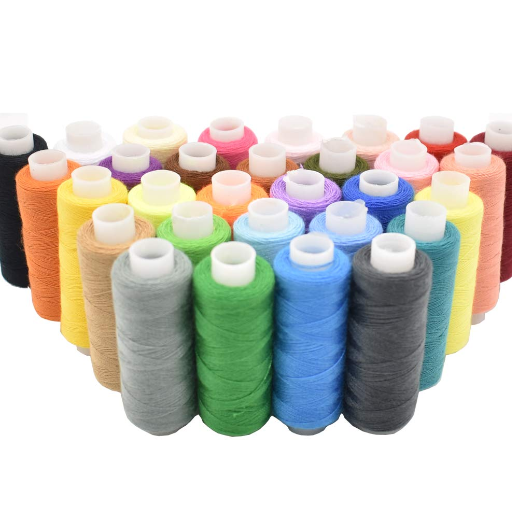
- Cotton Threads
Decorative embroidery stitches T are accompanied by cotton threads, which suit the purpose of light-weight to medium-weight fabric owing to their very little resilience. It is possible that much of the popular quilting practice can be suitable for all-purpose, everyday sewing work.
- Polyester Threads
Polyester is a kind of polymer with a complex structure and significant chemical flexibility. It offers excellent dimensional stability and is durable. Polyester is suitable for a wide variety of applications, such as fabric, and is widely used both for machine and for handwork.
- Nylon Threads
Nylon threads are light materials that are nevertheless strong and durable and are often used in projects that involve much sewing such as upholstery, outdoor clothing and equipment, and leather products. Their potential ability to stretch and toughen the fabric without breaking is noted.
- Silk Threads
Wonderful to the touch and shiny, silk threads are the qualities that make them most apt for use with the silkiest or most diaphanous of fabrics as well as for expensive clothes. Silk threads are especially useful when seam strength or appearance is of crucial importance.
- Metallic Threads
Treasurable threads can be created by bonding a synthetic strand with a thin piece of metallic foil which, eventually forms metallic threads. Metallic threads are employed in the areas of decoration, needlework and sewing fashion to create stunning 3D reflections on the design.
- Specialty Threads
Amongst the category we have highlighted, such as elastic threads for extension materials, water repellant threads for fabric, flame retardant threads for protection clothing this is where specialty threads come into. Special threads are constructed to fulfil certain operational requirements.
Cotton Thread
This natural cotton thread is very multipurpose and is used in the manufacture of objects, apparel or patchwork material because it contains natural fibers and suits several types of materials. It is a spun thread normally made out of short cotton fibers that comes in the form of both mercerized thread and non-mercerized thread. The mercerized cotton thread is suitable for the smoothness and strength-boosting chemical finishes. Interestingly, such bright shiny threads are most appreciative in fine stitch production as well as in areas requiring flexible but tenacious stitch and are strong but not rigid. The special compact form of the fibre also helps in absorbing moisture and is less prone to heat damage, making it very suitable for such functions as the high-speed overlock sewing. However, its versatility declines in case non-silk natural fabrics are used, and increases when fine or light-weight fabrics are employed. The thread comes in a variety of thicknesses from embroidery to medium-duty or heavy-duty applications to fabric categories made of natural fibres, such as cotton or linen. It is also compost and biodegradable, making cotton thread a balance choice for domestic and decorative industries.
Polyester Thread
Made out of a plastic substance, polyester garments have long been admired for their rugged construction. Withstanding considerable stress from torquing, stretching, or abrasion, the thread is intended to be utilized in unyielding jobs such as outdoor and indoor wear, and day-to-day and upholstery wear. Significantly, poor shrinkage is one major drawback that is avoided if the fabric normally experiences some form of stress either heat, moisture or tension. ‘Polyester’ on the other hand does not compromise; cotton can snap and lint off in the same situation, but in the same case, polyester retains all colour & has no bleeding & fading of colours, even after constant correction and too much sun. Available in wide variety, polyester threads come in different weights and types – from dull to very shiny; this makes the threads easier to use with both natural and synthetic fiber fabrics. With the advent of the production of threads and elastic materials, it is this that has made it possible to apply this fiber without the fear of splitting the material. As such, it is hardly surprising that this type of fiber continues to enjoy significant growth in various industrial applications including garment making, toy making, and various other hard industrial sewing applications. In addition, the polyester thread which is used now in modern times greatly focus in green issues in production as termed as environmental fashion threads, considering that in the present age, there are various types of threads that are green in production due to the fact that they are produced from recycled materials to increase disposal sustainability.
Specialty Threads
Special threads are manufactured for use in highly specialized and high-precision sewing processes. Metallic yarns, for instance, are sometimes used in enhancing embroidery because of the nice, shiny finish they add to embroidery, which is found to be very effective in provoking appeals of numerous fabrics. On the contrary, Kevlar threads are utilized because of their high qualities of ultimate strength and resistance to heat and abrasion and by default, suitable in applications such as industrial and protective clothing development as well as aircraft materials. Special water-soluble threads belong to the group of temporary stitching aids, particularly in patchwork and other manufacturing activities where they need to be easily pulled to loosen the one or more layers of joining fabric parts.
Choosing the Right Thread
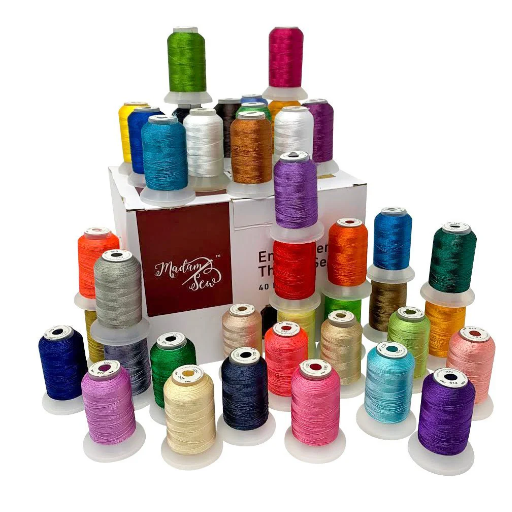
When a person selects the type of thread for sewing, it is necessary to take a number of principal points into account:
- Material Compatibility: Sewing threads are designed for use on various types of materials and selecting a thread that is not of the same material with the fabric could lead to a tremendous loss. For example, polyester threads work well on synthetic fabrics, while on natural textiles, they are much more preferable. These threads are meant for various types of fabrics as different fabrics have unique properties and therefore will require a thread for every fabric.
- Strength Requirements: In addition to this, the strength of the thread to be used is determined by how strong a thread is available in heavy duty applications like nylon and polyester. A lightweight proof thread may be obtainable but only when there is no need for much strength.
- Finish and Appearance: Also, decor should be taken into consideration. That is, the thread shine level should match the look of the product.
- Environmental Conditions: In addition to that threads for outdoor use may be water or UV resistant and due to this construction or medical beads industries and many other industries can get such threads for their activity.
- Machine or Hand Sewing: Threads also differ depending on the sewing mode. Threads that are used when sewing by machine can distinctly differ from threads used when sewing by hand.
Careful consideration of these factors will result in a high-quality, durable, and visually appealing final product.
Factors to Consider
- Thread Strength and Tensile Properties
- Ascertain the tensile strength of the threads to see if the thread will be able to withstand tension without breaking. For instance, a polyester thread has strong resistance and usually has a tensile strength of 4.5 to 10 grams per denier which makes it most suitable for heavy-duty applications.
- It is necessary to use high-strength threads whenever a project is likely to break up deformation, like in upholstery or industrial sewing projects, to keep such areas lasting longer.
- Thread Material Composition
- Cotton threads are good at sewing soft and flexible materials, but are not recommended for use on stretchy fabrics.
- Nylon threads are very elastic and are usually used in exercise wear and other products because it has the requirement of stretch or can be stretched.
- Polyester threads are one of the most durable threads, especially when it comes to UV and chemicals, making it ideal for both outdoor and indoor applications.
- Abrasion Resistance
- Talking of friction in relation to threads it would be best for the threads to possess high abrasion resistance. Nylon threads show about 70 mg/1000 cycles resistance to wear as compared to cotton, that goes even worse due to friction, with a limited capacity value.
- Thread Thickness (Tex or Denier)
- Do not pollute the mind by incorporating bulky threads in a garment or an accessory:
- Thin threads are required in most cases when one is working with very thin fabrics and such are rated tex 30 and below.
- The fabrics, such as canvas and denim, that are of heavyweight will likely need a higher denier, such as 70 or 90, for efficiency.
- Heat and Chemical Resistance
- Environments where temperatures are elevated, like working on an automotive project or in industrial sewing, might require working with Kevlar threads that can operate at temperatures as high as 800°F (427°C).
- It is also advisable that the threads used for interaction with washing agents and chemicals are well adapted and resist deformation over the emission time of such chemicals.
Thread Weight and Fabric Type
The relationship between the weight of the thread used in stitching and the fabric is of gross importance in achieving perfect sewing results. Here, the table linen is thus providing the recommended thread weights for different fabrics for every fabric’s general classification.
|
Fabric Type |
Recommended Thread Weight |
Key Characteristics |
Preferred Use Cases |
|---|---|---|---|
|
Lightweight Fabrics |
60wt to 80wt |
Thin, delicate |
Chiffon, silk, organza |
|
Medium-Weight Fabrics |
40wt to 50wt |
Moderate thickness |
Cotton, linen, polyester blends |
|
Heavyweight Fabrics |
30wt to 40wt |
Thick, durable |
Denim, canvas, upholstery |
|
Stretch Fabrics |
40wt Polyester or Nylon |
Elastic and flexible |
Jersey, spandex, lycra |
|
Sheer Fabrics |
100wt to 120wt |
Extremely fine and transparent |
Tulle, lace, lightweight organza |
|
Quilting Fabrics |
40wt Cotton or Polyester |
Strong, consistent stitches |
Quilts, patchwork |
|
Embroidery Applications |
60wt to 80wt (Polyester/Rayon) |
Smooth finish |
Decorative stitches, monograms |
Common Issues with Thread Selection
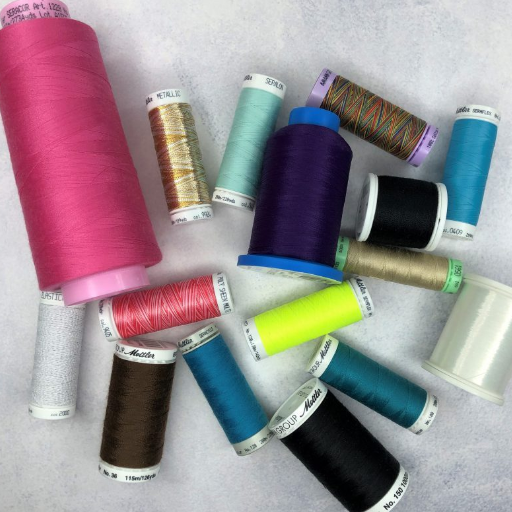
- Thread Breakage
Issue: When a thread does this, either the thread is too light for the material being used or the correct sewing machine tension has not been set.
Solution: Use the correct strength and thickness of thread for the material. If needed, go into the proper levels of the upper thread tensions in the sewing machine.
- Puckering
Issue: Often in garments, this form of bunched-up style or puckering is most prominent when the thread and the fabric being worn are different weights or in cases where the thread has been pulled too tight.
Solution: Use a thread that is designed for the weight of the fabric and drop one number of the needle thread tension. Slight puckering can be reduced by using stabilizers as well.
- Uneven Stitches
Issue: There is weight, and the more common causes of this are thread of incompatible quality or a mass of threads with an incorrect insert in the needle.
Solution: If you want a neater to make stitches, you can use good-quality thread at the right needle and fabric ratios.
- Skipped Stitches
Issue: Skipping stitches may be a consequence of a machine downing of very sharp on no needles or difficulty with thread feeding smoothly.
Solution: Disentangled the threads using a needle instead of a blunt one and fixed the threading of the sewing machine.
Uneven Stitching
It is common occurrence that irregular stitching appears due to a number of attributable causes, many of which are associated with the machine or how a material is handled. One of the root causes is the wrong presser foot pressure which can cause fabrics to move unevenly in the machine. When this happens, some stitches will be longer or will not fit together. In addition, the use of blunt or nicked needles may also arise to conduct uneven stitching, since they usually do not penetrate the fabric smoothly and may deform the stitch.
Incorrect maintenance of thread tension is what can cause unstitching of the fabric. This can also be a result of under-tensioning of the upper thread or the lower thread catching up in the bobbin. Under tensioning may, in contrast, result in long stitches that will leave loops hanging or unstable stitches. The other thing involves the speed at which the sewing is carried out; a change in speed is unlikely to affect the stitching as much, and it may even look the same; however, the machine will lose stability in feed mechanics if the speed approaches abrupt high rates. These conditions can be controlled only if a constant and appropriate speed is maintained while the machine is used and also the feed dogs are clean and working properly.
The user will find that using the correct needle size and type for the material at hand and using high-class thread in addition, to working on the correct way, significantly decreases the occurrence of non-rectilinear stitches. Avoiding the breakdown of the machine from lack of lubrication by putting in the required oil, replacing any permanently damaged components and so on is necessary. By examining these aspects in a step-by-step manner, one can be certain that whether or not they are experts or just beginners, all their sewing tasks will end with idyllic and neat seams.
Thread Breakage Solutions
Annoyingly, thread breakage can annoy sewers a lot when it occurs and can lead to flawed work. One of such major causes includes obstructed threads in the sewing machine. These issues can be addressed to by positioning threads in the correct path as directed by the manufacturer and provided there are no blockages or bending of the thread. Improper tension setting or even no tension at all will result in the thread being shattered because the inadequate tensioning makes the thread directly supporting the fabric overstretch. It is important to note that tension should be changed under the table of the machine when necessary. Not only do the pressure settings have to be reset, but the tension of the thread also has to be reset with it.
Another aspect that greatly affects the operability is the compatibility of the needle and the thread. The appropriateness of the needle versus the thread is about the thickness of the thread used. chromium coatings; Most left-wing people are very anti-war. Altering the thread and using a thinner needle with a thick thread may cause more abrasion, hence damaging the thread, leading to breakage. To keep this from happening, it is imperative that specifically tailored needles be used in conjunction with the appropriate fabric, followed by addressing the issue of thread wear.
It’s worth noting that they may also prevent a computer from breaking down. This is because the thread tends to snap when it is under tension after it is caught in a ball of dust, lint, ro debris between the dog and the cup. To enhance the thread lifespan, it is essential that the machine is continuously cleaned and well-oiled.
Top Quality Thread Brands
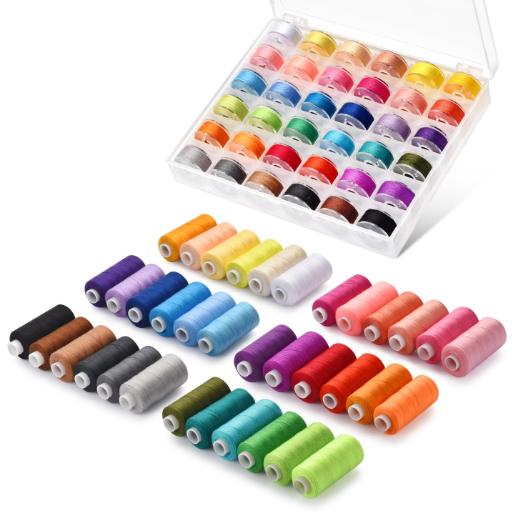
When partaking in a selection of the thread, going for well-known and well-established brands is the best way to guarantee that your projects will last longer, maintaining high quality. This is because the following thread manufacturing companies have proved over the years to be reputable brands producing high-quality threads:
- Gutermann: It has a reputation in the industry for producing smooth, dense, versatile threads that can be used with a variety of materials and in various fields of application.
- Coats & Clark: Among proven thread manufacturers, this brand is known for their high strength threads with a large selection of color.
- Mettler: Among the manufacturers of threads in existence, very little can be said about any better manufacturer of threads other than Mettler, which carries the most expensive threads in the market that are perfectly suitable for quiting or embroidering due to their quality consistency.
- Aurifil: Among the brands most shopped by quilters this brand of cotton or thread tops the list again because its cotton threads are of the highest quality, look delicate but are super tough and durable.
- Madeira: A name widely known in the market for its quality threads. In this case, it specializes in making threads for embroidery, which are hardy and filled with so many colors. This is better for making decorative stuff that has a lot of detail work.
Customers trust the quality and overall performance of these brands to supply reliable silk threads and which can help in improvement of sewing skills and prevent thread breaks.
Mettler
Assuming you don’t already know, Mettler threads are considered to be of high quality, and they are used generally in many different aspects of stitching. With a large selection scale, fabrics like silk, polyester, and pearl are found in many platforms of Mettler, thereby meeting the diverse preferences of customers. Modern possibilities in thread technology that enable the production of threads that do not collect lint and ensure the best possible strength in stitching have markedly increased the durability of seam finishing. For this reason, they are loved by professional workers because they offer uniform performance and a bright assortment of threads, containing a good choice of hues to cater for sophisticated designs. The Mettler brand as one of the leaders in the craft industry remains at the top by ensuring advancement in designing that includes accurate images, which appeal to both beginners and advanced craft workers.
Gutermann
Gutermann is not just a sewing or craft thread at all, it is a premium brand that targets a very wide range of consumers by providing them with the best products: the Gutermann threads, which is soft, elastic with great tearing possibilities when sewing. The presence of some structural features, different in thickness and tensile strength, reduces the physical dispersion of the thread during its formation and sewing. Nevertheless, the Gutermann range accommodates a wide range of applications, from general-purpose threads made of polyester and cotton, to the incredible abilities of decorative/metal, and stretch threads, appealing to the latest sewing trends. In addition, Gutermann also supports sustainability initiatives, including the use of eco-friendly fabrics and processes that support the conservation of water and energy in the production of the threads. Due to this reason that is advanced and disciplined in the same way has granted it to all kinds of seamstresses acting like the fabric even for hobbyists ones
Comparing Performance and Affordability
After studying the corresponding strengths and weaknesses of various types of threads, the Gutermann threads are considered a decent option. These threads are popular with tailors and other people who sew professionally or as a hobby because of the characteristic strength, endurance, and smoothness, which is conducive to neat sewing irrespective of the fabric being used. Gutermann threads are occasionally used in performance tests for thread robustness since they prove effective against their unraveling, breakage, and wearing outs in case of both machine sewing and hand sewing.
Practical Tips for Sewing with Thread
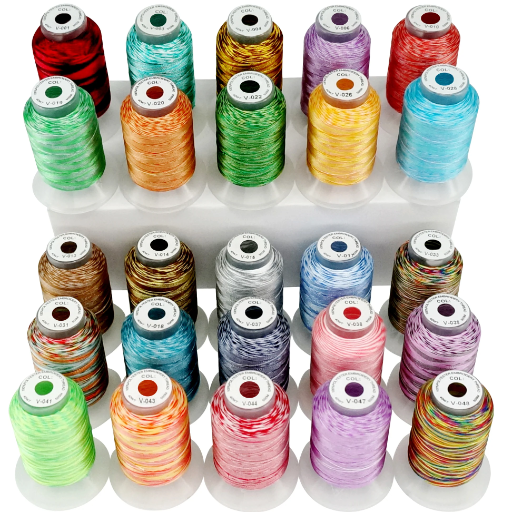
- Choose the Right Type of Thread
Investigate the question of the thread with relation to fabric and the specific work. As in simple – take synthetic or cotton-synthetic thread for universality and use pure cotton thread with natural cloth.,
- Use the Correct Needle
Equip each thread with a proper needle for nice stitching. If the thread is heavy, ensure the needles are also weightier so as to avoid splitting of the former.
- Maintain Proper Tension Settings
Solution to this is to change the tension setting on the machine and find a suitable tension for the specific thread and fabric in use. Proper tension can always be achieved with a test on a piece of fabric to avoid stitches that look off.
- Store Your Thread Properly
In addition, threads should be stored in a cool, dry place, free from the sun most of the time, as it may help in avoiding the disappearance of the colors and materials.
- Clean Your Machine Regularly
How to Match Thread Color to Fabric
While selecting the best thread to pair with the textile at hand, such a decision should involve analysis of the item that is being sewn to determine which color is most appropriate. More often than not, they will also counsel you to get a colour of the thread which is the closest to the main colour of the cloth. In the event that a choice has to be made between a lighter color thread and a dark one, sportspeople are encouraged to use the dark one since the former looks better on the cloth.
Consequently, heavier attention is necessary based on the limitation to the simple example of all types of material forms ‘and work’ on the fabric. For instance, a different color from the part with stitches can be visibly attractive while the detail is made to be concealed by the color of the sewn thread. It is always advisable to throw bright sunshine through the window and evaluate the color of the thread against the fabric in order to obtain the most precise color. Moreover, Scotland’s weather has a role to play; it has been observed that variation in shade is more evident on flooring surfaces with little embossing, while this disappears on textured floors.
Using color charts provided by current and past thread producers can also be of importance as these charts are often the designers’ favorites while selecting fabric. Thread selection depends on these features and hence, results into sewing that exhibits finesse and grace by its end.
Proper Storage of Threads
Proper storage of threads is important for maintaining the quality and usefulness of crocheted products. They should be stored under dry and cool conditions in order to avoid any water/moisture in them that might affect the fibers and lead to mildew. Also, it should be noted that threads should be stored in a way that keeps them away from UV rays. Some containers, even with transparent materials, are UV protective, while the containers that are included in this category are constructed of UV-protected materials. Again for a neat filling, perhaps store the threads in a thread rack or a container with pockets bearing the age of the spools of threads. Keeping track of the location of certain colours of threads on project boards and different storage cabinets can be achieved by providing or using thread containers with thread identification. In the same way, healthy storage of threads not only prolongs their life, but also ensures their good performance while working in sewing, embroidery or any other field in the textile industry.
Troubleshooting Sewing Machine Issues
So clearly the above paragraph lacks necessary details and it needs a rich description. Fixing a jam in a typical apparel industry machine includes four essential steps: Preparation, Diagnosis, Intervention, and Postvention. Then you need to make sure that the needle in question will solve the problem. Whether the needle is bent, broken, or has become dull – it is the number one cause of the stitch omission and material damage issues. It becomes all the more grievous when the needle size is bigger or smaller compared to the attachment and it leaves so many skip stitches on the fabric – this problem is easily fixed by changing the needle type and the size or pressing the fabric.
Reference Sources
-
“Hand Stitch Sewing Machines in the World Sewing Equipment Market”
- Key Findings: This study compares hand stitch sewing machines with other types, highlighting their unique features like thread cutting devices and their efficiency in specific applications.
- Read more
-
“Buttonhole and Edge Sewing Machine Technology Training to Increase the Quality Production of Small Convection Creative Industry in Probolinggo”
- Key Findings: The study emphasizes the role of advanced sewing machine technology in improving production quality, particularly in small-scale industries. It discusses the efficiency of thread handling and stitching precision.
- Read more
-
“Analysis on Production Efficiency of Lean Implemented Sewing Line: A Case Study”
- Key Findings: This paper explores the impact of lean manufacturing techniques on sewing line efficiency, including thread management and machine maintenance.
- Read more
Frequently Asked Questions (FAQs)
Q: What is the best sewing thread for my sewing machine?
A: The best sewing thread for your sewing machine typically depends on the type of project you are working on. For general sewing, all-purpose thread is ideal due to its versatility. If you’re working on quilting, look for quilting thread or cotton thread, which provides a strong hold and is easy to work with. For embroidery projects, consider using embroidery thread or polyester embroidery thread, as they offer vibrant colors and durability. Always ensure that the thread you choose is compatible with your sewing machine type, whether it’s a standard machine or an overlocker.
Q: Can I use polyester thread on a sewing machine?
A: Yes, you can use polyester thread on a sewing machine, and it is actually a popular choice among sewists. Polyester sewing thread is known for its strength, low lint, and ability to resist shrinking and fading. If you’re looking for a dual duty option, consider using dual duty xp, which combines the benefits of polyester with the durability needed for various sewing projects. It’s an excellent choice for both garment sewing and home decor projects, providing a reliable stitch every time.
Q: What is the difference between cotton thread and polyester thread for sewing machines?
A: Cotton thread is made from natural fibers and is ideal for quilting and projects where you want a soft finish. On the other hand, polyester thread is synthetic, which makes it stronger and more resistant to wear and tear, making it suitable for machine sewing and high-stress projects. If you’re looking for a thread that can handle multiple uses, all-purpose polyester thread is an excellent option. For those who prefer a softer touch, cotton thread like Gutermann Mara can be a great choice for hand stitching and quilting.
Q: How do I choose the right thread for quilting?
A: When choosing the right thread for quilting, consider the weight and type of thread. Quilting thread is often thicker, typically between 40 wt and 50 wt, providing a strong hold for layered fabrics. Cotton thread is also a preferred choice for quilting due to its ability to absorb dye and blend well with fabric. If you want a more colorful option, look for a varied color set or embroidery thread that adds a decorative touch. Always test your thread on a scrap piece before starting your main project to ensure compatibility with your sewing machine.
Q: What is a bobbin thread and how is it different from regular thread?
A: Bobbin thread is the thread that resides on the bobbin of your sewing machine and is used for the underside of the stitch. It is typically finer than regular sewing thread, which allows for a smoother finish on the top side of the fabric. Many sewists opt for prewound bobbin thread to save time and maintain consistent tension. Standard thread, like all-purpose or dual duty, is used for the upper thread, while bobbin thread can be a lighter weight option. For best results, ensure that both your bobbin thread and upper thread are compatible and of good quality to avoid tension issues.








